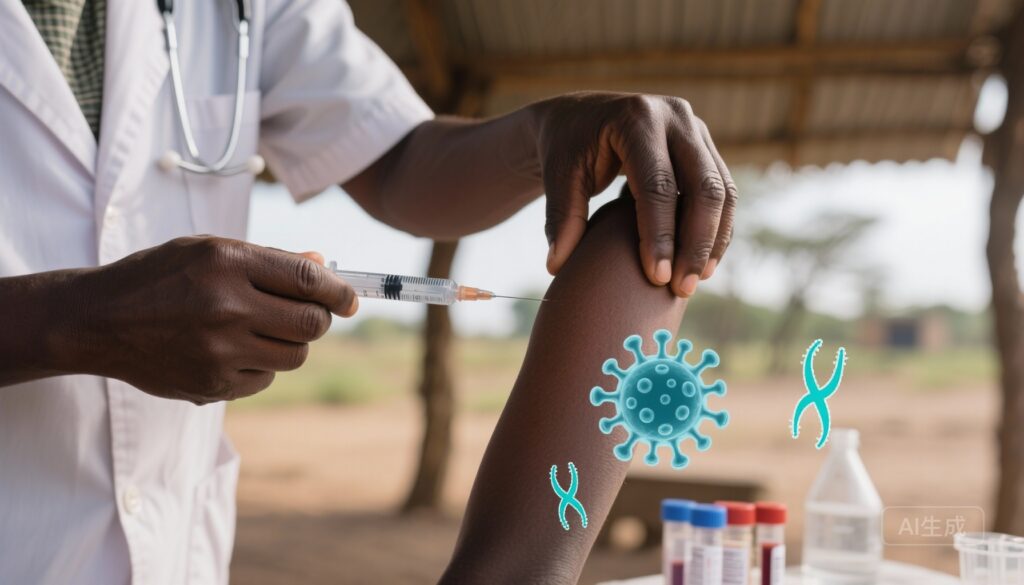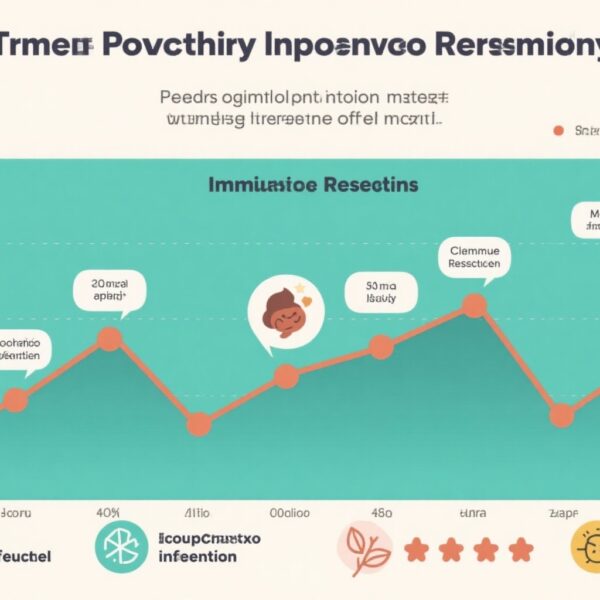Highlights
– A single intramuscular dose of ChAdOx1 RVF was generally safe and tolerable among 24 vaccine recipients in Uganda, with no serious adverse events reported.
– Reactogenicity was mostly mild or moderate; local reactions occurred in 71% of vaccinees but in no placebo recipients.
– Neutralising antibodies were detected by day 14 in 75–90% of vaccine recipients across dose groups; the highest dose (5.0 × 10^10 viral particles) produced consistent responses sustained through day 84.
Background
Rift Valley fever (RVF) is a mosquito-borne zoonosis caused by Rift Valley fever virus (RVFV), a Phlebovirus that periodically causes outbreaks in livestock and humans in Africa and the Arabian Peninsula. RVF presents with a spectrum from mild febrile illness to severe disease including haemorrhagic fever, encephalitis, and pregnancy loss in animals; human case fatality in severe disease can be substantial. There is currently no vaccine licensed for routine human use, and effective human vaccines that can be deployed rapidly and safely during outbreaks remain an unmet public health need.
Study design
This single-centre, single-blind, randomised, placebo-controlled, dose-escalation phase 1 trial (ClinicalTrials.gov NCT04672824) was conducted in Masaka, southwestern Uganda, to evaluate safety, tolerability, and immunogenicity of ChAdOx1 RVF, a replication-deficient chimpanzee adenovirus-vectored vaccine encoding RVFV glycoproteins.
Eligible participants were healthy, non-pregnant adults aged 18–50 years who lived in the clinical site’s service area, were seronegative for RVFV nucleoprotein, and had not previously received other adenovirus-vectored vaccines. Thirty participants were sequentially enrolled into three dose cohorts: group 1 received 5.0 × 10^9 viral particles (vp), group 2 received 2.5 × 10^10 vp, and group 3 received 5.0 × 10^10 vp. Participants within each cohort were randomized to vaccine or saline placebo in a 2:1 ratio for group 1 (4 vaccine:2 placebo) and 5:1 for groups 2 and 3 (10 vaccine:2 placebo each). Each participant received a single intramuscular injection in the non-dominant deltoid and remained masked to assignment; study staff were unmasked.
Cop rimary outcomes were solicited local and systemic reactogenicity within 7 days and unsolicited adverse events within 28 days post-vaccination (analysed by intention to treat). Secondary outcomes included humoral (anti-Gn/Gc IgG and neutralising antibodies) and cellular (interferon-γ T-cell) responses to RVFV glycoproteins measured up to day 84.
Key findings
Participants
Between May 5 and Sept 29, 2022, 30 participants were enrolled: 24 (80%) men and six (20%) women. Median age was 25 years (IQR 22–33). Vaccine recipients numbered 24 (4 in group 1; 10 in group 2; 10 in group 3) and 6 participants received placebo (2 per cohort).
Safety and tolerability
Overall, the vaccine was well tolerated. No serious adverse events were reported during the follow-up period. Adverse events were predominantly mild or moderate and self-limiting.
Local solicited adverse events were reported in 17 of 24 vaccine recipients (71%) and in 0 of 6 placebo recipients. Injection-site pain was the most frequent local event: 1 of 4 (25%) in group 1, 5 of 10 (50%) in group 2, and 7 of 10 (70%) in group 3. Other local symptoms included warmth and itching with variable frequencies across doses (warmth: group 1 two of four [50%], group 2 three of ten [30%], group 3 two of ten [20%]; itching: group 2 three of ten [30%], group 3 two of ten [20%]; none in group 1).
Systemic solicited adverse events were reported in 20 of 24 vaccine recipients (83%) and in five of six placebo recipients (83%). Common systemic symptoms varied by dose cohort. In group 1 the most frequent systemic symptom reported was chills (three of four vaccinees [75%] vs one of two placebo recipients [50%]). In group 2 the common systemic events included fever (two of ten vaccinees [20%] vs none in placebo) and myalgia (four of ten [40%] vs none). In group 3 systemic events were more frequent and included fever (four of ten vaccinees [40%] vs none), headache (six of ten [60%] vs one of two placebo recipients [50%]), fatigue (seven of ten [70%] vs one of two [50%]), and malaise (seven of ten [70%] vs one of two [50%]). Most systemic reactions were transient and resolved without sequelae.
Humoral immunogenicity
Neutralising antibody responses were detected early. By day 14 after vaccination, neutralising antibodies were detected in 3 of 4 participants (75%) in group 1, 9 of 10 (90%) in group 2, and 9 of 10 (90%) in group 3. The highest dose (group 3, 5.0 × 10^10 vp) produced the most consistent and durable antibody responses: by day 28 neutralising antibodies were present in 10 of 10 participants (100%), and at day 84 in 9 of 10 participants (90%).
Binding IgG responses to the RVFV glycoproteins Gn and Gc were evident; in the highest-dose group (group 3) anti-Gn and anti-Gc IgG responses emerged earlier than in the lower-dose groups.
Cellular immunogenicity
Interferon-γ–producing T-cell responses (measured by ELISpot) peaked earlier than antibody responses for all dose groups, consistent with the expected kinetics of adenoviral-vector vaccines. Robust T-cell induction was observed across doses, supporting a cellular component to the vaccine-induced immunity.
Interpretation and clinical relevance
This first-in-human phase 1 trial of ChAdOx1 RVF in an RVF-endemic setting demonstrates an acceptable safety profile and a favourable immunogenicity signal after a single dose. The vaccine elicited both humoral (neutralising antibodies and anti-Gn/Gc IgG) and cellular (IFN-γ T-cell) responses, with the 5.0 × 10^10 vp dose producing the most consistent and sustained neutralising antibody titres through at least day 84.
From a public health standpoint, a single-dose vaccine that induces early T-cell responses and rapid neutralising antibodies is attractive for outbreak response and for protecting high-risk groups (e.g., livestock handlers, veterinarians, and frontline health workers) in endemic and at-risk regions. The ChAdOx1 platform has logistical advantages, including known manufacturing pathways and experience from other vaccine efforts that may accelerate development.
Expert commentary and mechanistic insights
Neutralising antibodies targeting the RVFV envelope glycoproteins Gn and Gc are widely considered a key correlate of protection in animal models and are therefore a critical readout in early human trials. The early peak in interferon-γ–secreting T cells is consistent with adenovirus-vector immunobiology and may provide an additional layer of antiviral defence, especially in settings where rapid viral control is needed.
However, whether the magnitude and durability of antibody and T-cell responses observed here translate into clinical protection against infection or severe disease remains to be established in larger, efficacy-focused studies. Current knowledge from animal models supports a biologically plausible protective effect, but human correlates of protection for RVF are not yet definitively defined.
Limitations
Key limitations of the trial include small cohort sizes (n=30 total), single-centre conduct, short-term follow-up (primary immunogenicity reported through day 84), and the enrolment of healthy, mostly young adult participants (80% male), which limits generalisability. Pregnant women and older adults—populations at elevated risk of severe outcomes in many infections—were excluded and will require dedicated safety evaluation. Study staff were unmasked, which could introduce bias in event recording, although participants were masked. The trial was not designed to assess vaccine efficacy against clinical RVF illness.
Next steps and research priorities
The investigators recommend further evaluation of the 5.0 × 10^10 vp dose in larger, more diverse populations and in settings at risk for RVF outbreaks. Priority next steps include phase 2 dose-expansion studies to refine safety and immunogenicity across age groups and sexes, longer-term follow-up to characterise durability, evaluation of immune correlates of protection where feasible, and ultimately randomized, controlled efficacy trials or controlled human challenge models if ethical and scientifically justified.
Additional programmatic considerations will include manufacturing scale-up, cold chain and delivery strategies suitable for outbreak response in resource-limited settings, and incorporation of high-risk groups such as pregnant women in a staged, safety-focused approach.
Conclusion
This phase 1 trial provides encouraging early evidence that a single dose of ChAdOx1 RVF is tolerable and immunogenic in healthy adults in an endemic African setting. The 5.0 × 10^10 vp dose elicited the strongest and most durable immune responses in this small study and is a rational candidate for further clinical development. Larger trials are required to confirm safety in broader populations and to determine whether the immunogenicity observed confers protection against RVFV infection and disease.
Funding and registration
Funding: UK Department of Health and Social Care through the UK Vaccines Network. ClinicalTrials.gov registration: NCT04672824.
Reference
Anywaine Z, Serwanga J, Ggayi AM, et al. Safety, tolerability, and immunogenicity of the ChAdOx1 RVF vaccine against Rift Valley fever among healthy adults in Uganda: a single-centre, single-blind, randomised, placebo-controlled, dose-escalation, phase 1 trial. Lancet Infect Dis. 2025 Nov 11:S1473-3099(25)00565-1. doi: 10.1016/S1473-3099(25)00565-1. PMID: 41237791.



